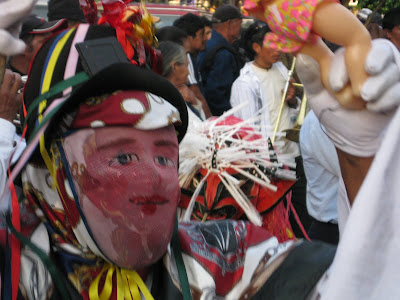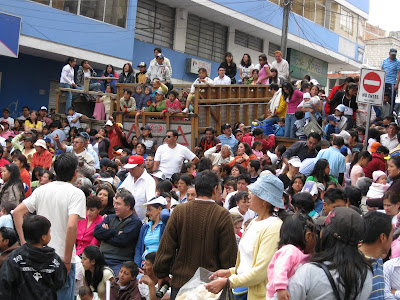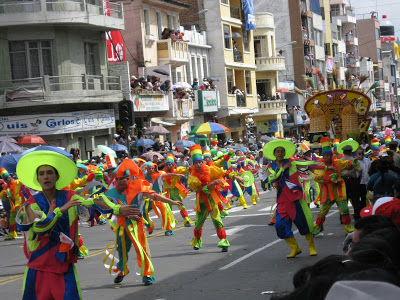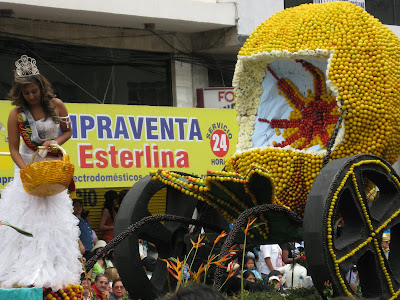 As those of you who read this blog regularly have probably interpreted by now, the theme lately has been one of holidays. That’s because for a few months straight, it seems as though the holidays celebrated in Ecuador come one after another. Carnaval, perhaps the wildest of them all, is amongst the last in the string of festivities, before the devoutest of Ecuadorians settle into a prolonged period of subdued reflection, and the rest just go back to business as usual.
As those of you who read this blog regularly have probably interpreted by now, the theme lately has been one of holidays. That’s because for a few months straight, it seems as though the holidays celebrated in Ecuador come one after another. Carnaval, perhaps the wildest of them all, is amongst the last in the string of festivities, before the devoutest of Ecuadorians settle into a prolonged period of subdued reflection, and the rest just go back to business as usual.To call Carnaval a religious holiday doesn’t quite explain it. Of course, since some version of Carnaval is expressed in so many countries around the world, and each with its own long history, it defies a tidy explanation.
Ecuador’s own modern manifestation of Carnaval can be traced back to a fusion of indigenous and Spanish traditions, although today’s revelers have taken it into yet other directions. On the indigenous side of the story, various local cultures celebrated some version of what the Inca would have called the Pawkar Raymi, which is to say, the festival of the blossoming. Such celebrations featured the ritual throwing of water and flowers, in order to invoke the primal energy of flowering and rebirth.
The Spanish already had their own Carnaval celebrations, which happened to coincide with the indigenous festival. That’s really no coincidence, when you consider the fact that holidays around the world have taken shape around the many, universally recognized lunar and solar events every year.
European Carnaval is of course an event which takes place prior to Lent. Before beginning forty days of personal sacrifice symbolic of Jesus’ own tribulations and crucifixion, Europeans wanted to have a good time. So they began a tradition unto itself, where open revelry became as ensconced in the calendar as Easter did. Easter falls always after the Spring Equinox, and Jesus’ death and resurrection represented the ultimate Passover lamb, that Jewish holiday which, in turn, is tied with the Spring Equinox, and is itself representative of the rebirth inherent of the beginning of Springtime.
Here in the Andes, the local cultures too were able to recognize the mystery of the Spring Equinox and celebrated accordingly, and when the Spanish and indigenous cultures collided, so too did their holidays, fusing together much as the people. Today Latin America is unified in part by its mestizo culture and heritage, and also by holidays drawing from both sides of the Atlantic.
What does that mean for Carnaval in Ecuador today? Mestizo teens, hurling water balloons. At each other, and often, at strangers. And while Carnaval is technically observed beginning the Friday before Ash Wednesday, the water balloons start flying not long after New Year’s Day, and reach a crescendo the day before Lent begins.
The final days of Carnaval find many Ecuadorians on the street, openly wielding water hoses in front of their houses, barrels and buckets of water raining down from terraces above, and drive-by water balloon attacks. Young women and obvious foreigners seem to be preferred targets. If you’re blonde or a woman, that means you’d better watch out, and have a good sense of humor, every time you’re outside, for several weeks. Even the best sense of humor can begin to wear down after several unexpected dowsings, and an afternoon at work at a language institute employing several dozen foreigners begins to look pretty soggy during the last days before the Carnaval vacation.
This year, like the previous two years I’ve spent in Cuenca, left me fortunately dry. But then, I’ve been thoughtful about how I get around during the first months of the new year. No bike rides, first of all. Those wait until Lent. A walk downtown is best avoided, and if you do need to go downtown, you’d best walk towards the flow of traffic, and better yet, on the driver’s side of the street. You see, the driver, being occupied with driving, can’t very well toss a balloon at you. Furthermore, choose a route without many residential homes, where kids like to hang out on the 2nd or 3rd story terraces. Does this sound excessive? Perhaps, but not if you’d rather stay dry. Anything short of that and you’ll get hit, at least a few times. I guess in total, I’ve been hit by one water balloon in Cuenca, during the one bike trip I chose to take last year.
That’s not to say I haven’t been a target. Upon leaving Cuenca, my luck always seems to run out. There was, for example, the case of my first Carnaval trip in Ecuador. That left my friends and I all covered in water and spray foam, as you’ll see towards the bottom of the link. Last year we opted to stick around and celebrate with Nancy’s family, which culminated in a family reunion in Biblián, roasted guinea pig dinner, and the ritual smearing of dry corn starch all over everybody’s hair.
“Why corn starch?” you may ask. This, too, seems rooted in indigenous tradition, where the taita inti, or father sun, was chosen at the beginning of each Pawkar Raymi. Today, they instead refer to taita carnaval, and anyone can be Father Carnaval if they’ve got white hair from all the corn starch. If you’ve got a beard like me, you’re even more of a target. Best of all, after you get the white powder thrown in your face, you’re supposed to say “thank you.”
This year, we decided to venture out of Cuenca yet again, heading up to the community of Ambato and the surrounds. Ambato is distinct in its Carnaval celebrations for at least two reasons. First, throwing water is prohibited. That sounded good to me. Second, and even more intriguing, was their famous parade, known as the Fiesta de las flores y las frutas.
Before we got to Ambato, we’d had quite a few arrangements to make. This year, Carnaval weekend and Valentine’s Day happened to coincide, which left many of the hotels in the area full, far in advance. In fact, of the several hotels in Ambato we tried to book, all were full but one, which had doubled its prices and demanded a minimum two night stay and a 50% deposit to be made in their bank account three days before arriving. We didn’t like those conditions very much, so we got a fresh list of hotels in the area from Nancy’s sister, who works at a travel agency. The first place on the list that we called indeed had vacancies, and put us down for a night with no further strings attached.
So Nancy, Tamia and I got on a bus and headed for Ambato. 30 minutes from our destination, we thought it would be a good idea to call ahead and get the exact location. Which revealed that our hotel was not in Ambato at all, but in Baños de Ambato, a different community altogether. That put us in a dilemma. On one hand, Baños is a nice place, and buses went back and forth along the 40 minute route between towns very frequently. On the other hand, we had planned to spend our time between Ambato and a few small communities on the other side of town from Baños.
In travel, and in life in general, we can rarely predict with any accuracy what our experiences are going to be like until they actually unfold. Attempting to do so will often leave us disappointed, and worse, blind to potential opportunities that arise, but which we never foresaw. Traveling, then, is often an exercise in being flexible, and open to new experiences. We hadn’t planned to stay in Baños, but after a few minutes of weighing our options from our bus seats, we opted to stay there after all with the hotel we had reserved, rather than wander into a city unknown to both of us, with no place to stay. When we arrived in Baños, we discovered that our hotel was located literally across the street from the bus station, run by teenagers, and with lousy rooms but very nice views:
Punctuating our visit to Baños of course was the main purpose of our trip, the Fiesta de las flores y las frutas. The morning after our arrival, we woke up early and got back on a bus to Ambato. A quick city bus ride downtown left us a couple of blocks from the epicenter of the celebration, and a long line of people in the middle of the street.
“Why the line of people?” we asked a stranger at the end of the line.
“To cross the street,” she told us.
Well, it must be worth crossing a street like that, and so we did. And this is the sight that greeted us:
We didn’t know what the Fiesta had in store for us yet, but we were sure by now that it was worth seeing, judging from the dense throngs of people packed into the long, wide avenue. Every sidewalk was packed, and above, so were all the balconies and rooftops. Along the side streets, people had parked their trucks, and people were packed onto them as well. The street itself, as far as you could see in either direction, was filled with walkers, including ourselves, all trying to find a place to sit down.
We chose to go right, and look for a place. Any open seat we came across on the sidewalks was already claimed. After going down about ten blocks, we could see the first float off in the distance, coming our way. And in front of it was a line of police officers, who formed a wall and drove all those left in the street forward. We had little choice than to head back the way we had come, and with a stroke of luck, we found a couple of empty seats.
Or that is to say, a man found us, and then sold them to us for $2 each. Apparently, each store owner along this street has the coveted opportunity to sell sidewalk space in front of his shop, and after seeing the number of people who were now facing the ultimatum of having a seat reserved or getting off the street altogether, two dollars seemed like a fair price to pay. We also happened to be on the side of the street which still received the morning shade, and there was a bucket of iced beer for sale right behind us. Here’s a glimpse from within the crowd, which may help to illustrate our good fortune in finding a nice place to sit:
And so, happy with our location and view to the street, we settled in with a cold beer and enjoyed the show:
Here you see one of many floats featured in the parade, most of which followed the recurring theme of a beautiful woman throwing flowers or soft fruits into the crowd, accompanied by a float constructed almost entirely of flowers and fruits. Here was featured a donkey made of delicious purple capulies and orange uvillas, and standing on a sort of cake made from black olives, as far as I can tell.
Between each float came a retinue of dancers, each with their own costumes:

Brian Horstman is a teacher of English as well as a traveler, writer, photographer and cyclist. His interest in traveling around Latin America began while he was living in New Mexico, where he began to experience the Latino culture that lives on there. From there he spent time in Oaxaca, Mexico and has since been living in Cuenca, Ecuador and will be living in Chile starting in 2011. Cal’s Travels chronicles some of his more memorable experiences from Mexico and Ecuador, as well as some side trips to other parts.


















